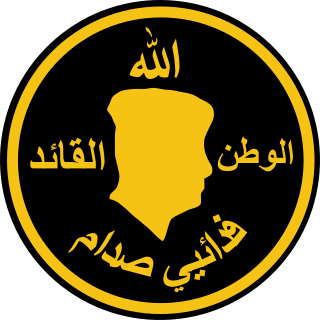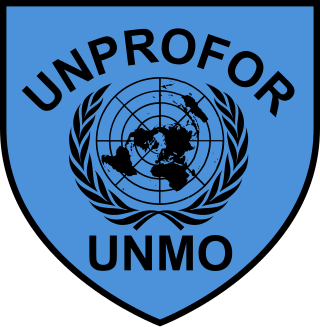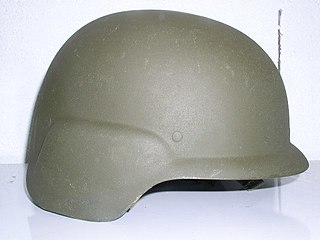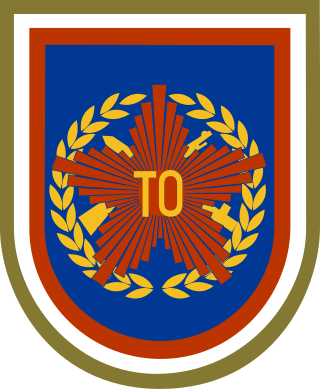Related Research Articles

Fedayeen Saddam was a paramilitary Fedayeen organization intensely loyal to the Ba'athist Iraqi government of Saddam Hussein. The name was chosen to mean "Saddam's Men of Sacrifice". At its height, the group had 30,000–40,000 members. The Fedayeen operated completely outside the law, above and outside political and legal structures.

The United Nations Protection Force was the first United Nations peacekeeping force in Croatia and in Bosnia and Herzegovina during the Yugoslav Wars. The force was formed in February 1992 and its mandate ended in March 1995, with the peacekeeping mission restructuring into three other forces.

The Stahlhelm is a German military steel combat helmet intended to provide protection against shrapnels and fragments or shards of grenades. The term Stahlhelm refers both to a generic steel helmet and more specifically to the distinctive German military design.

The Battle of Vukovar was an 87-day siege of Vukovar in eastern Croatia by the Yugoslav People's Army (JNA), supported by various paramilitary forces from Serbia, between August and November 1991. Before the Croatian War of Independence the Baroque town was a prosperous, mixed community of Croats, Serbs and other ethnic groups. As Yugoslavia began to break up, Serbia's President Slobodan Milošević and Croatia's President Franjo Tuđman began pursuing nationalist politics. In 1990, an armed insurrection was started by Croatian Serb militias, supported by the Serbian government and paramilitary groups, who seized control of Serb-populated areas of Croatia. The JNA began to intervene in favour of the rebellion, and conflict broke out in the eastern Croatian region of Slavonia in May 1991. In August, the JNA launched a full-scale attack against Croatian-held territory in eastern Slavonia, including Vukovar.

The SPECTRA helmet or CGF Gallet Combat Helmet is the PASGT-style ballistic helmet in use with the French military, and the armies of several other countries. Built by CGF Gallet, it weighs 1.4 kg (3.1 lb), is available in three sizes, and is made from ultra-high-molecular-weight polyethylene Spectra fibers, produced under license from Honeywell.

The Serbian Autonomous Oblast of Western Slavonia was a Serbian self-proclaimed Serb Autonomous Region (oblast) within Croatia. It was formed on 12 August 1991 and was subsequently included into the Republic of Serbian Krajina. It was eliminated and reintegrated into Croatia in May 1995, during Operation Flash.

Civilian checkpoints or security checkpoints are distinguishable from border or frontier checkpoints in that they are erected and enforced within contiguous areas under military or paramilitary control. Civilian checkpoints have been employed within conflict-ridden areas all over the world to monitor and control the movement of people and materials in order to prevent violence. They have also been used by police during peacetime to help counter terrorism.
The Lovas killings involved the killing of 70 Croat civilian residents of the village of Lovas between 10 and 18 October 1991, during the Croatian War of Independence. The killings took place during and in the immediate aftermath of the occupation of the village by the Yugoslav People's Army (JNA) supported by Croatian Serb forces and Dušan the Mighty Forces. on 10 October, two days after Croatia declared independence from Yugoslavia. The occupation occurred during the Battle of Vukovar, as the JNA sought to consolidate its control over the area surrounding the city of Vukovar. The killings and abuse of the civilian population continued until 18 October, when troops guarding a group of civilians forced them to walk into a minefield at gunpoint and then opened fire upon them.
The Voćin massacre was the killing of 43 civilians in Voćin, Croatia, by the Serbian White Eagles paramilitary unit on 13 December 1991, during the Croatian War of Independence. The massacre was carried out after the unit was ordered to abandon the village before the Croatian Army recaptured the area in Operation Papuk-91. All the victims were local Croats, save one Serb, who had tried to protect his neighbours. Gunfire was the leading cause of death, though some of the victims were killed with axes or chainsaws, or were burned to death. The victims exhibited signs of torture and were left unburied. On the night of 13–14 December, the White Eagles dynamited a 550-year-old church in the village.

The Territorial Defense[a] was a component of the armed forces of the former Socialist Federal Republic of Yugoslavia that was the primary means of organized armed resistance against an enemy under the Constitution of Yugoslavia. The forces acted as a Home or National Guard which roughly corresponded to a military reserve force or an official governmental paramilitary. Similar to the US National Guard, each of the Yugoslav constituent republics had its own Territorial Defense military formations, to remain separate from the Yugoslav People's Army (JNA), which also maintained its own reserve forces and could take command of Territorial Defense in case of war. This would be done under the command of the Presidency of Yugoslavia as Supreme Commander of Armed Forces through the Minister of Defense, who was the highest military rank that could command both Yugoslav People's Army and Territorial Defense simultaneously under the constitution. While the President of Yugoslavia was in function he was under constitution supreme commander of armed forces, including the JNA and TO, and he could also pass duties as supreme commander to minister of defense.

United Nations Security Council resolution 819, adopted unanimously on 16 April 1993, after reaffirming resolutions 713 (1991) and all (1992) subsequent resolutions, the Council expressed concern at the actions of Bosnian Serb paramilitary units in towns and villages in eastern Bosnia and Herzegovina, including attacks on civilians, the United Nations Protection Force and disruption to humanitarian aid convoys. The resolution marked the UN's first civilian "safe area" being declared; it failed to prevent the Srebrenica massacre.

The Modèle 1951 helmet was a military helmet used by the French military, iconic of the Algerian War. It replaced a variety of helmets used during the Second World War, including the Adrian helmet, Modèle 1945 helmet and American-supplied M1 Helmet.
The Battle of Glođane was fought during the Kosovo War in the village of Glođane first on March 24, 1998, and again later on August 11, 1998. It involved the Kosovo Albanian militant group known as the Kosovo Liberation Army (KLA) and the Yugoslav military and Serbian police forces. The clashes signified a sequence of military offensives initiated by the Yugoslav army and Serbian police to counter the increasing presence of the Kosovo Liberation Army (KLA) within Kosovo Albanian villages.

The Zvornik massacre refers to acts of mass murder and violence committed against Bosniaks and other non-Serb civilians in Zvornik by Serb paramilitary groups at the beginning of the Bosnian War in 1992. It was part of a wider campaign of ethnic cleansing in the Bosnian War: by one estimate, 40,000 Bosniaks were expelled from the Zvornik district.

The Doboj ethnic cleansing refers to war crimes, including murder, deportation, persecution and wanton destruction, committed against Bosniaks and Croats in the Doboj area by the Yugoslav People's Army and Serb paramilitary units from May until September 1992 during the Bosnian war. On 26 September 1997, Serb soldier Nikola Jorgić was found guilty by the Düsseldorf Oberlandesgericht on 11 counts of genocide involving the murder of 30 persons in the Doboj region, making it the first Bosnian Genocide prosecution. The International Criminal Tribunal for the former Yugoslavia (ICTY) classified it as a crime against humanity and sentenced seven Serb officials.
The Glogova massacre was the mass murder of 64 Bosniak civilians by Serb forces, consisting of the Yugoslav People's Army (JNA), Bratunac Territorial Defence (TO), local police, and paramilitaries from Serbia, on 9 May 1992. Miroslav Deronjić, the head of the "Bratunac Municipal Board" established by the Serbian Democratic Party (SDS), was sentenced to 10 years in prison by the International Criminal Tribunal for the former Yugoslavia for ordering the massacre.
The OR-201, also designated Kasda OR-201 Model 76 or M-76 for short, is a combat helmet of Israeli origin. Developed in the 1970s, the OR-201 was one of the world's first ballistic helmets. It was subsequently exported on a large scale and has been used by many militaries worldwide.
The M33 Helmet is a steel combat helmet designed in the 1930s in Italy, and was the standard combat helmet of the Regio Esercito up to World War II, and of the Esercito Italiano well into the Cold War.

The Sarajevo Operation was an operation by the Yugoslav Partisan Army which led to the liberation of Sarajevo and Central Bosnia in March-April 1945.

The Bosanski Šamac ethnic cleansing refers to war crimes, including murder, looting, ethnic cleansing and persecution committed against Bosniaks and Croats in the Bosanski Šamac area by the Yugoslav People's Army and Serb paramilitary units from 17 April until November 1992 during the Bosnian war. The area was later incorporated into the newly formed proto-state Republika Srpska.